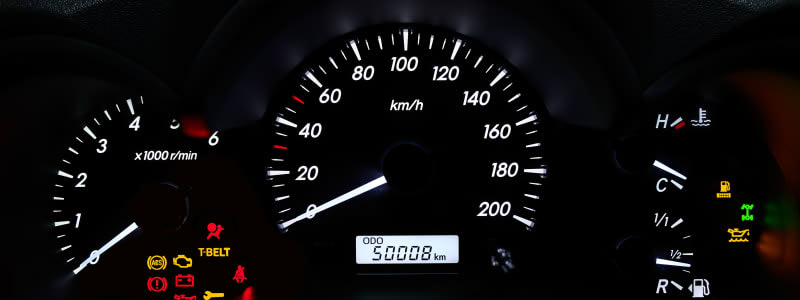
Every year, the country's garages receive thousands of inquiries from car owners who have observed that one of the car's warning lights in the dashboard is on. You don’t have to worry too much, as it doesn't have to be serious when a warning light shows up in the dashboard, but it can get serious if you ignore the warning and just drive on.
A car is equipped with a variety of warning lights, all of which indicate that something is wrong with the car. The warning lights may have a light yellow / orange or red color.
The main warning lights
If you are among the drivers who may not know about the significance of the different warning lights in the dashboard, we have listed the most important ones below.
Several of the symbols can have different colors to signal the degree of importance of the detected fault on the car, and thus, an overlooked yellow warning may go red at some point if ignored.
Basically, the colors mean this:
Red: Stop the car as soon as possible and turn off the engine. Follow the instructions in the instruction manual. If in doubt, call for assistance.
Yellow: An action is required. Stop the car and turn off the engine. Follow the instructions in the instruction manual - you will often be able to drive to the nearest garage.
Green: Used for information and requires no action on the part of the driver.
| Symbol | Warning |
|---|---|
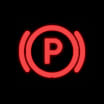 |
Handbrake Light. If the handbrake light is on, check if you have released the handbrake. Even if you have released it, it may be stuck, or the brake fluid is missing, or perhaps the brake lining is worn down. |
 |
Engine Temperature is too High. The engine may be overheated. This may be because the car has run out of coolant. Stop the car and check for coolant. |
 |
Seat Belt. The seat belt symbol - one or more passengers in the car has not fastened the seat belt. The lamp turns off when all passengers are fastened. |
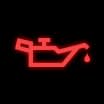 |
Engine oil - red. If the oil can symbol is red, the oil pressure is too low. Stop the car immediately and call for road assistance that'll take your car to a garage. |
 |
Engine oil - yellow. If the oil can symbol is red the car lacks engine oil Stop the car, and after 10 minutes you can check the oil level while the car is on an even surface. There must be oil between the minimum and maximum mark on the stick. If oil is missing, see in the car’s instruction manual what type your car uses. Add oil and turn on the car for a maximum of 5 seconds. If the lamp turns off, you can drive on. If the lamp remains lit, call for assistance. |
 |
Battery. The battery symbol - there are issues with the power supply. This may be because the generator is not working. Drive straight to the garage. When the symbol is lit, several of the car's electronic safety measures may be out of service. |
 |
Braking System. The brake symbol - is the handbrake pulled up? Otherwise, the symbol may signal a failure of one or more of the car's braking systems. Look in the car's instruction manual for more information. |
 |
ESP, ESC. Anti-slip, Anti-spin, ESC/ESP symbol - the car's Electronic Stability Program is active. It usually happens on wet and slippery roads. Drive carefully, avoid any emergency braking, and remove the foot from the accelerator to lower the speed. |
 |
Airbag. Airbag and Seat Belt System Failure - Front passenger airbag is turned off. Can happen if a child car seat is placed on the front seat. Check with your mechanic if everything is as it should be. |
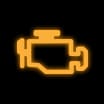 |
Engine. Engine symbol - tells the driver that something is wrong with the engine. If the light is orange, immediately drive the car to a garage where the mechanic can troubleshoot and find the problem via the car's computer. If the symbol is red, stop the car and call for auto help! |
 |
ABS. ABS symbol - tells the driver that something is wrong with the ABS and/or ESP system. In most cases, the brakes still work, even if the anti-block system (ABS) and/or ESP have a fault. You will therefore be able to drive to the nearest workshop to correct the error. |
 |
Brake pads or lining. The brake symbol - the brake pads are worn down and the car's brake pads must be replaced. It is possible to drive in the car, but not for long before you have to change the lining on the pads. |
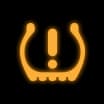 |
Low Tyre Pressure, TPMS. Tyre pressure is important for both safety and fuel consumption. Cars younger than 2014 have the automatic tyre pressure gauge, TPMS, installed which monitors your car's tyre pressure. If the low tyre pressure light is on, drive to a gas station and fill the tyres with air until you reach the correct pressure level. This is measured either in bar or psi, and you will find the correct level in your car's instruction manual. Keep in mind that the tyres should be somewhat cool when you fill on air. |
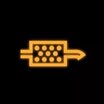 |
Diesel Particulate Filter. If this lamp is lit, it is most likely due to the fact that your diesel car's particulate filter is clogged or otherwise out of order. It is expensive to replace completely, so you should have a mechanic clean the particle filter of soot first. It is mandatory for your car to have a well-functioning filter, as you cannot pass MOT because of limits to the amount of exhaust gases. |
 |
Glow Plug Indicator. This lamp is seen in the diesel car's dashboard when you have put the key in the ignition. You must wait to start the car until the lamp goes out, because then the car's glow tube is sufficiently heated. It takes 5-10 seconds. |
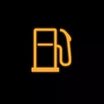 |
Low Fuel Indicator. The symbol illuminates when you need to refuel the car. It varies how much gasoline is left in the tank, but you should drive straight to a gas station. |
 |
Fog Light, Rear. The rear fog lamp of the car is on. Make sure it matches the weather conditions so you don't confuse other drivers on the road. |
 |
Service Power Steering. There is a failure somewhere in the power steering system. It might be due to the power steering fluid level, a leaking gasket, a defective sensor or perhaps a worn steering rack. The car's computer can sometimes tell you the code for which problem you're looking at. |
If the lamp is yellow or orange, then it is a signal that you should be aware of a possible fault, stop the car, investigate and make sure that the car is repaired in the foreseeable future.
On the other hand, if the warning light is red, stop the car immediately and call for help.
What does it cost to find the fault on my car?
It can be hard to say exactly what it costs to find the fault of your car specifically. If you have to troubleshoot your car, it is a good idea to get quotes from several places to compare the location of the garages, reviews from other car owners and not least prices. Car owners who compare prices for troubleshooting tasks at Autobutler can save an average of 18%, which is equivalent to DKK £68.
Follow these 3 tips and avoid problems
Use the car's instruction manual to get to know the most important symbols. Always carry an instruction manual so you can use it as a "reference book".
If the symbols are yellow or orange, check if you can continue driving. This might be the case sometimes. Remember, however, to have the car checked at your local garage in the foreseeable future.
If either the engine light or the oil light glows red, immediately pull over - all the way to the hard shoulder if you are on the motorway - and call for auto help.
Listen to the car's warnings
Phrases like “He overlooked all the warning signs” just don't seem to apply when it comes to your car - do they?
It may well be a harmless error when a warning light comes on, but who dares to just drive on with the risk that something is wrong?
Most car owners are sensible enough to drive to the garage and check what is wrong with the car, but in fact it turns out that there are also many who completely choose to ignore the warning lights in the dashboard.
If you belong to the last group, it can eventually cost you a lot of money. That is why Autobutler usually hears this message from the country's many garages: If a warning light comes on, stop the car before it's too late.
The most important signs are the most dangerous
The warning lights in your car are not all of equal importance. If they are to be ranked by importance, then the oil lamp and the engine lamp are the ones that should make you react immediately. If these warnings are ignored, you risk that the entire engine breaks down, for example because it lacks engine oil.
The garages affiliated with Autobutler generally report many inquiries from car owners who state that the engine light is on. An engine light glowing orange is a serious issue as it means the engine has gone into an emergency program. As a motorist, you must therefore take the warning seriously.
If you have ignored a warning lamp with a serious engine breakdown, you should not expect to be covered under the car's warranty, as you yourself have caused the damage.
So it is not only the warning lights that can glow red. Your garage bill might also blow up if things go wrong and your car’s engine breaks down.
Immune drivers
Today, newer cars have a myriad of warning lights that tell the driver that a door is not properly closed, that the rain sensor is not working properly or that tire pressure should be checked.
Some cars have over 30 warning lights, and the many lights certainly help increase road safety.
But as a driver, it can be difficult to keep track of all the warning lights. A British study has shown that as much as 98 percent of the motorists surveyed did not even know the most common warning lights.
At the same time, the many warning lights can also make car owners immune or blind to the signals of the car, as a number of warning lights do not necessarily indicate that something is seriously wrong with the car. Although a lamp is lit, it is often possible to drive on, and therefore the warning symbols may be given less and less importance.
If you do not check the warning lights in time, it can have serious consequences. Therefore, the main rule is that if a warning light is on, first check in the car's instruction manual what the symbol means before driving on. Is the color red, always stop the car as soon as possible.
See the warning lights in your car
The symbols can vary depending on the model and year of the car - therefore, always refer to your car's instruction manual to get the most accurate picture of the warning lights in your particular car.
Alfa Romeo, Audi, BMW, Chevrolet, Chrysler, Citroen, Dacia, Fiat, Ford, Honda, Hyundai, Jeep, Kia, Land-Rover, Mazda, Mercedes-Benz, Mini, Mitsubishi, Nissan, Opel, Peugeot, Renault, Saab, Seat, Skoda, Smart, Suzuki, Toyota, Volkswagen/VW, Volvo.







